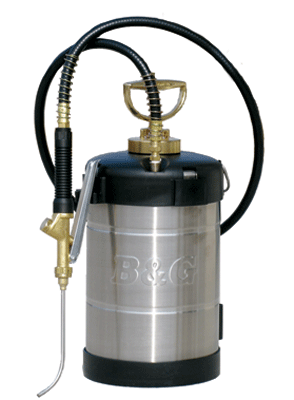B&G Versafoamer HH - Great Tool for Small Termite Jobs
Posted by Andrew Greess on Aug 26, 2019
The B&G Versafoamer HH can be a valuable tool for companies that only require an occasional termite foaming application.
The B&G Versafoamer HH is small, lightweight, portable and easy to use manual termite foamer. It is manually operated so it is great for small termite foaming jobs. It is probably not the best choice for large termite foaming jobs or frequent termite foaming jobs.
The B&G Versafoamer HH is basically a B&G 1 Gallon Sprayer with a couple of modifications. It has a suction tube with 2 small holes in it that allows air to get into the tube to make foam. It also uses a different spray valve than the regular B&G 1 gallon sprayer.
Because it is a manual termite foamer, it does not have a lot of ability to adjust the foam volume & consistency. The only real way to adjust the foam is to adjust the amount of foam concentrate you add to your mix. We recommend testing the unit and adjusting the foam concentrate amount to get your desired foam consistency with plain water before using the Versafoamer HH with termiticide.
Once you have used your Versafoamer HH, it is important to do some regular care and maintenance to keep it in good operating condition.
Here are some suggested maintenance tips for your manual B&G Versafoamer HH.
1. Always release the pressure. Never store your termite foamer under pressure. Releasing the pressure will extend the life of soft parts such as orings, gaskets, hose, etc.
2. Always clean your termite foamer out. Do not store your foamer with chemical in it. Dried, hardened chemical will impact the operation of your termite foamer and will be much more difficult to clean out. We recommend cleaning your foamer out after each use. Triple rinse the tank with clean water then pump up the unit and run clean water through the hose and spray valve.
3. Do regular maintenance. We recommend tearing the unit down and replacing wear parts annually. Rubber parts in particular should be replaced. It is much cheaper (and less stressful) to do your preventative maintenance when you are slow and have time, rather than waiting to have a problem in the field when you need your equipment to perform.
4. Secure your foamer in your vehicle. Loose equipment gets damaged and/or damages other equipment. This kind of damage is an unnecessary waste of time and money.
5. If your unit is not making good foam, here are some tips:
A. Check for air leak. Replace worn parts.
B. Inspect the brass suction tube inside the tank. There two little bitty holes at the top - one on either side. They must be open. This is where the air comes from to get to the tip where the foam is made. If the holes are plugged or the tank is filled above these hole the foamer with not function properly.
C. There is a little mesh screen between the tip and the wand. The screen must be there and it has to be clean and unclogged to function properly. This is where the foam is made.
Hope this helps.


